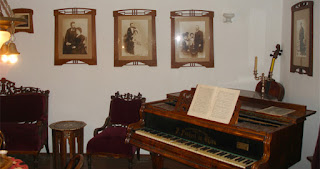Negotin is one of those beautiful cities on the Danube, in eastern Serbia, which has many attractions. Manifestation Mokranjac's days is a good opportunity to visit the house where the founder of the Serbian music spent his childhood. Mokranjac is the composer of the national style, because he combined traditional folk music with European musical experience. He was born in 1856, he was a composer, conductor and teacher credited with laying the foundations of modern music pedagogy. He wrote 15 handfuls. He lived until 1914, mainly in Belgrade. In 1964 authorities in Negotin bought and restored the house into the Museum Mokranjac, as was the nickname of the family, who received it because of the village Mokranje, near Negotin, where the composer's father was born.
The birth house of Stevan Mokranjac includes postulate which is performed in ambient style town house of the late 19th century. On the ground floor there is a permanent exhibition of Stana Djuric Klein on the Mokranjac spiritual and sacred creation, and analysis of the compositions. This is the area in which the chamber concerts are held, and other cultural activities. On the first floor there is the ethnological postulate with significant objects from the time of the famous Serbian composer.
In the first room are, mostly, the photographs, letters, diplomas, the most faithful testimony of the life of this family, about four children who, because of the untimely death of her husband, a mother herself raised. Stevan was a very musical child, and he received the first violin as a gift from his uncle, when he was only ten years old. When he was 15 years old, his mother sold the house and the children moved to Belgrade. In the Serbian capital, he finished high school and entered the Faculty of Sciences, because then in Serbia there was no school for music education. However, talent and love of music led him to the First Belgrade Singing Society. He became the youngest member, and very quickly, thanks to a scholarship from the Government, he went to study in Leipzig and Rome. But there was not enough money to gain a diploma of the Academy, so he had to study with private proffesors, and that helped him a lot in his further work.
Mokranjac was still a student when he began to compose. Very interesting is his work on the handfuls. Traveling through Serbia, Macedonia, Bosnia, Kosovo, throughout our environment, he listened to folk songs and recorded them, and of those that were characteristic for a place he created handfuls. Hence the name. Similarly was with spiritual music and formation of the liturgy. Mokranjac did not deal just with composing. After his return to Belgrade, he was conductor of the Jewish Choral Society, founder and member of the string quartet.
Among the photographs, to the Negotin people is especially dear the one from 1892, which was immortalized Mokranjac's only official arrival in his native city. On that occasion the Belgrade Singing Society premiered sang sixth handful dedicated to this part of Serbia.
In the memorial house of Mokranjac, on a large number of boards are records and photographs that testify about a quarter of his conductor's work in Belgrade Singing Society, concerts and competitions. In the Singing Society he meets his future wife, Marija, the niece of Uros Predic, famous Serbian painter. Visitors can see their love correspondence, photographs with their son Momcilo. It is interesting that the son lived to see the first festival days of Mokranjac in Negotin in 1966.
Son of the famous composer donated to the museum all exhibits of the house in Belgrade. First of all, his working desk, chair, portraits from 1913, painted by Uros Predic. Here is his personal piano, and the piano on which he played as a teacher in the first music school founded in the Serbian capital. Also, there is Lira and lighthouse, awards the Mokranjac got from the Belgrade Choral Society for 25 years of his work. Lighthouse, on which they carved the names of his works, symbolize that Mokranjac was light in music culture of Serbia, because many believe that Mokranjac, for our musical literacy, was the same as Vuk Stefanović Karadžić for the Serbian alphabet.
Stevan Stojanović Mokranjac, died in Skopje in 1914, as a refugee, during World War I, and nine years later, thanks to the Belgrade Singing Society, the mortal remains were transferred to Belgrade.






Нема коментара:
Постави коментар